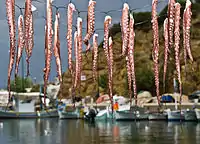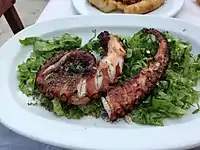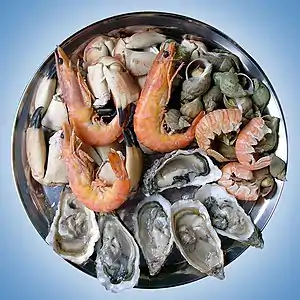Octopus as food
Humans of some cultures eat octopus. The arms and sometimes other body parts are prepared in various ways, often varying by species and/or geography.
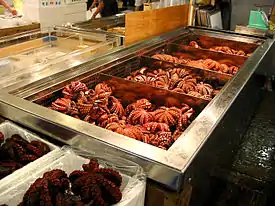
.jpg.webp)
Octopuses are sometimes eaten or prepared alive, a practice that is controversial due to scientific evidence that octopuses experience pain.
Dishes by geography
Japan

Octopus is a common ingredient in Japanese cuisine, including sushi, takoyaki and akashiyaki.
Takoyaki is a ball-shaped snack made of a wheat flour-based batter and cooked in a special takoyaki pan. It is typically filled with minced or diced octopus, tempura scraps (tenkasu), pickled ginger, and green onion.[1][2] Takoyaki are brushed with takoyaki sauce, similar to Worcestershire sauce, and mayonnaise. The takoyaki is then sprinkled with small strips of laver and shavings of dried bonito.
Korea
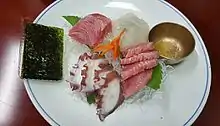
Giant octopus, long arm octopus, and webfoot octopus are common food ingredient in Korean cuisine.
In Korea, some small species are sometimes eaten raw as a novelty food. A raw octopus is usually sliced up, seasoned quickly with salt and sesame seeds and eaten while still squirming posthumously.
Nakji bokkeum is another popular dish in Korea. It is a type of stir-fried food made with chopped octopus.
Maldives
Miruhulee boava is a Maldivian delicacy made of octopus tentacles braised in curry leaves, chili, garlic, cloves, onion, pepper, and coconut oil.[3]
Mauritius
In Mauritius and Rodrigues, octopus, known by its Mauritian Creole name "Ourite" is commonly eaten especially in coastal regions as it is found abundantly in Mauritian waters, although a sharp decline has been observed recently. Popular octopus dishes include the masala octopus curry or boiled octopus in spicy tomato sauce, known as the "Daube".
Greece
A common scene in the Greek islands is octopuses hanging in the sunlight from a rope, just like laundry from a clothesline. They are often caught by spear fishing close to the shore. The fisherman brings his prey to land and tenderizes the flesh by pounding the carcass against a stone surface. Thus treated, they are hung out to dry, and later will be served grilled, either hot or chilled in a salad. A common preparation technique involves classic Greek spices and seasonings, often including olive oil, garlic cloves, oregano, pepper, and lemon juice.[4] On the whole, octopus is considered a superb meze, especially alongside ouzo.[5]
Spain
In the Spanish region of Galicia, polbo á feira (market fair-style octopus) is a local delicacy. Restaurants which specialize or serve this dish are known as pulperías.
Portugal
.jpg.webp)
In Portugal octopus is eaten à lagareiro (olive oil miller style — roasted with potatoes, herbs, onion, garlic, and olive oil),[6] or stewed with rice (arroz de polvo), as well as breaded and then deep fried, with rice and beans.
Tunisia


Octopus is a common food in Mediterranean cuisine such as Tunisian cuisine.
On the Tunisian island of Djerba and Kerkennah islands, local people catch octopuses by taking advantage of the animals' habit of hiding in safe places during the night. In the evening, they put grey ceramic pots on the sea bed. The morning of the following day they check them for octopuses sheltered there. Also unlike its other Maghreb neighbour, seafood, including octopus is used extensively in Tunisia, grilled, roasted, in couscous, pastas or chorbas.
Nutritional value
According to the USDA Nutrient Database (2007), cooked octopus contains about 56 kilocalories (Calories) per 100 grams, and is a source of vitamin B3, B12, potassium, phosphorus, and selenium.[9]
Octopus heads are high in selenium and are a risk for cadmium poisoning, even in small amounts.[10] In 2010, over 29 mg of cadmium—14 times higher than the permitted level—was found in the heads of octopus imported to South Korea from China.[11]
See also
References
- "蛸焼" [Takoyaki]. Dijitaru daijisen (in Japanese). Tokyo: Shogakukan. 2012. OCLC 56431036. Archived from the original on 2007-08-25. Retrieved 2012-06-22.
- "Takoyaki". Encyclopedia of Japan. Tokyo: Shogakukan. 2012. OCLC 56431036. Archived from the original on 2007-08-25. Retrieved 2012-06-22.
- Masters, T. (2006). Maldives. Lonely Planet. p. 84. ISBN 978-1-74059-977-1.
maldivian cuisine.
- "Archived copy". Archived from the original on 2019-10-01. Retrieved 2018-08-31.CS1 maint: archived copy as title (link)
- "Greek Food: Mezedes". www.greecefoods.com.
- "Lagareiro Style Octopus". Cooking Lisbon. Retrieved 16 August 2015.
- Gregory-Smith, John (2018-07-16). Turkish Delights: Stunning regional recipes from the Bosphorus to the Black Sea. Octopus. ISBN 978-0-85783-596-3.
- Guides, Fodor's Travel (2019-06-18). Fodor's Essential Turkey. Fodor's Travel. ISBN 978-1-64097-141-7.
- "Basic Report: 35054, Octopus (Alaska Native)". USDA. Retrieved 27 May 2014.
- "Seoul squirms over octopus head war". Reuters. October 21, 2010.
- "Poisonous Cadmium Found in Octopus Heads". Arirang News. September 13, 2010.
External links
 Media related to Octopus as food at Wikimedia Commons
Media related to Octopus as food at Wikimedia Commons Octopus at Wikibook Cookbooks
Octopus at Wikibook Cookbooks
